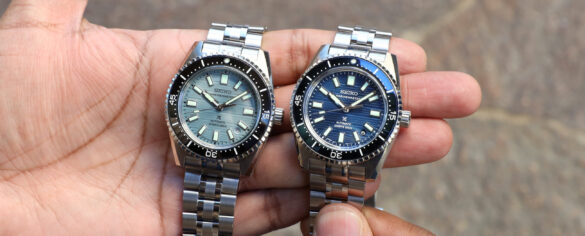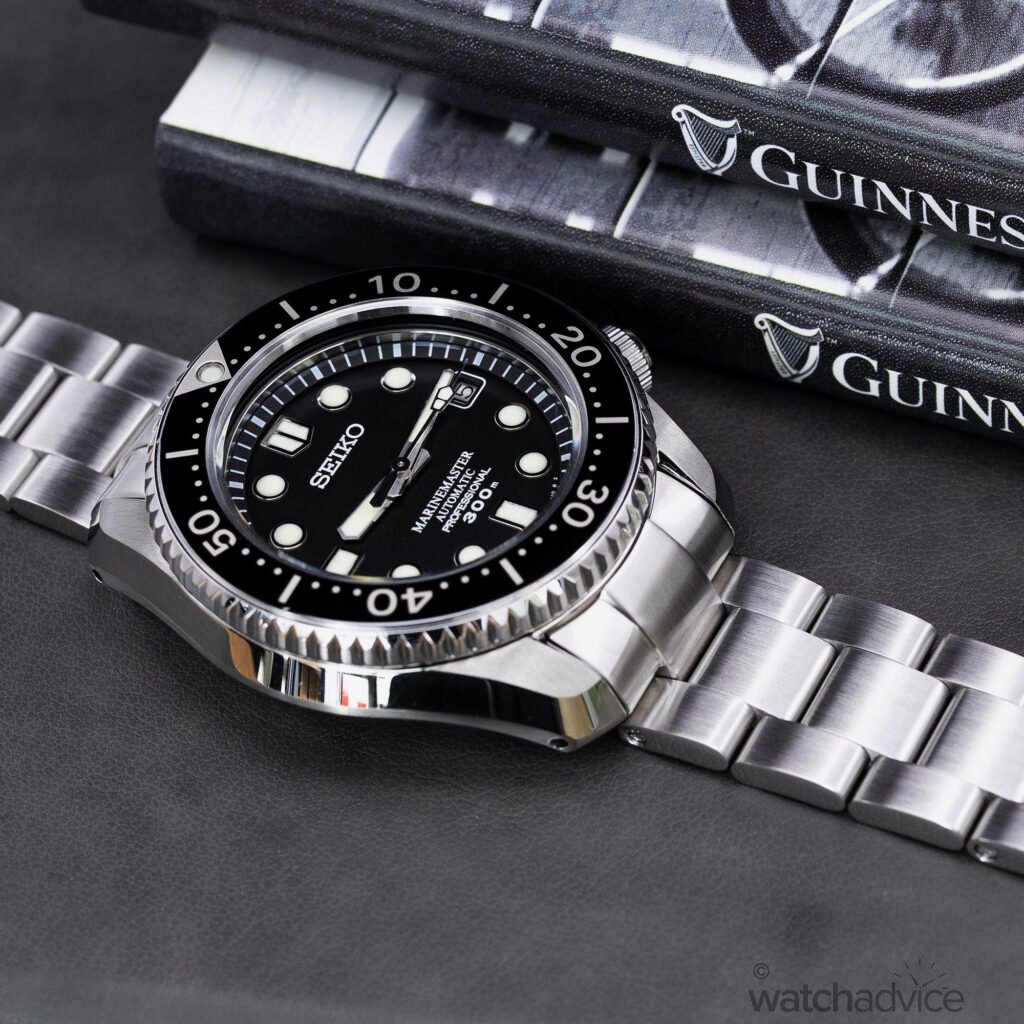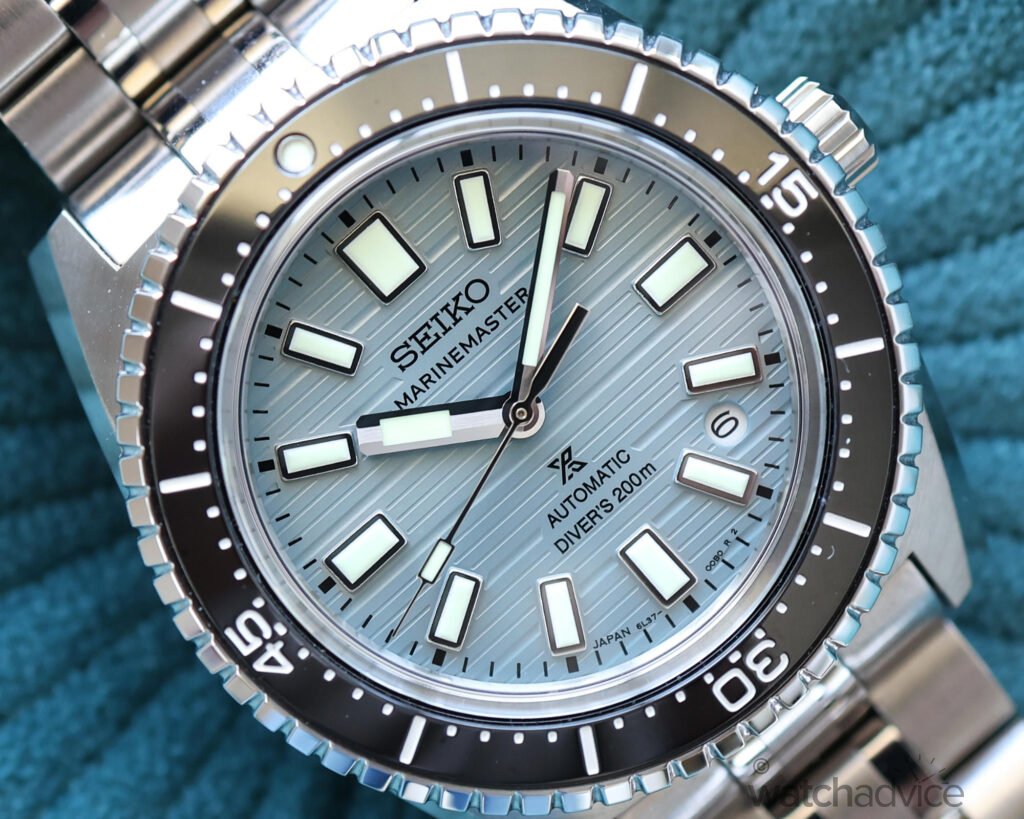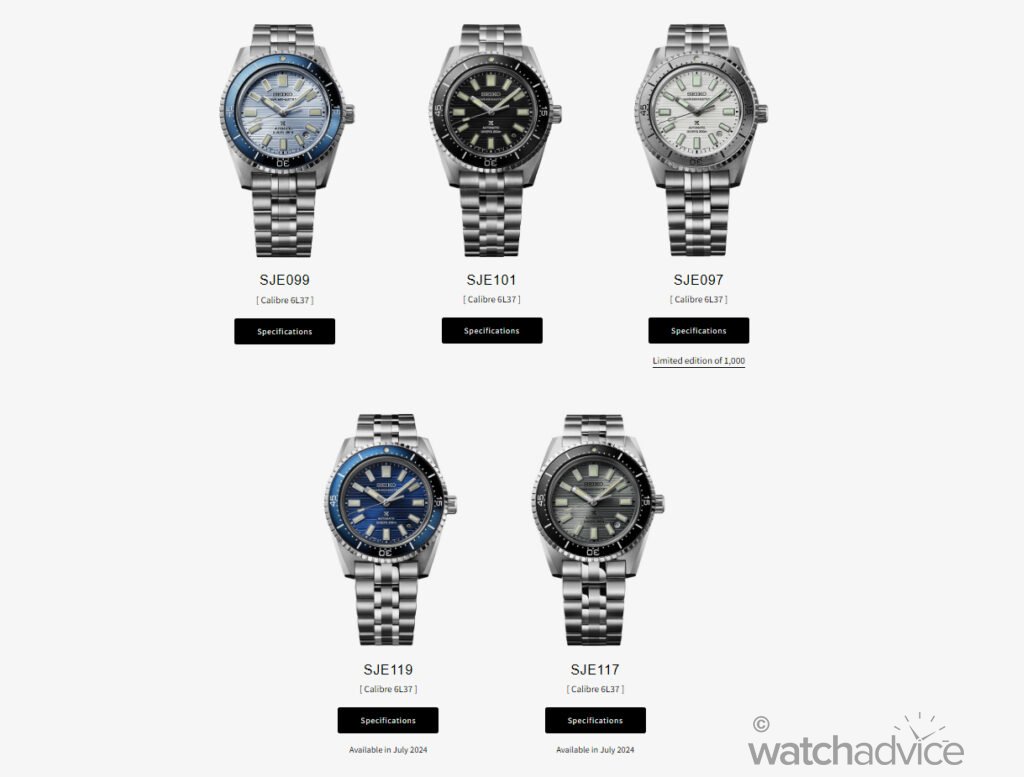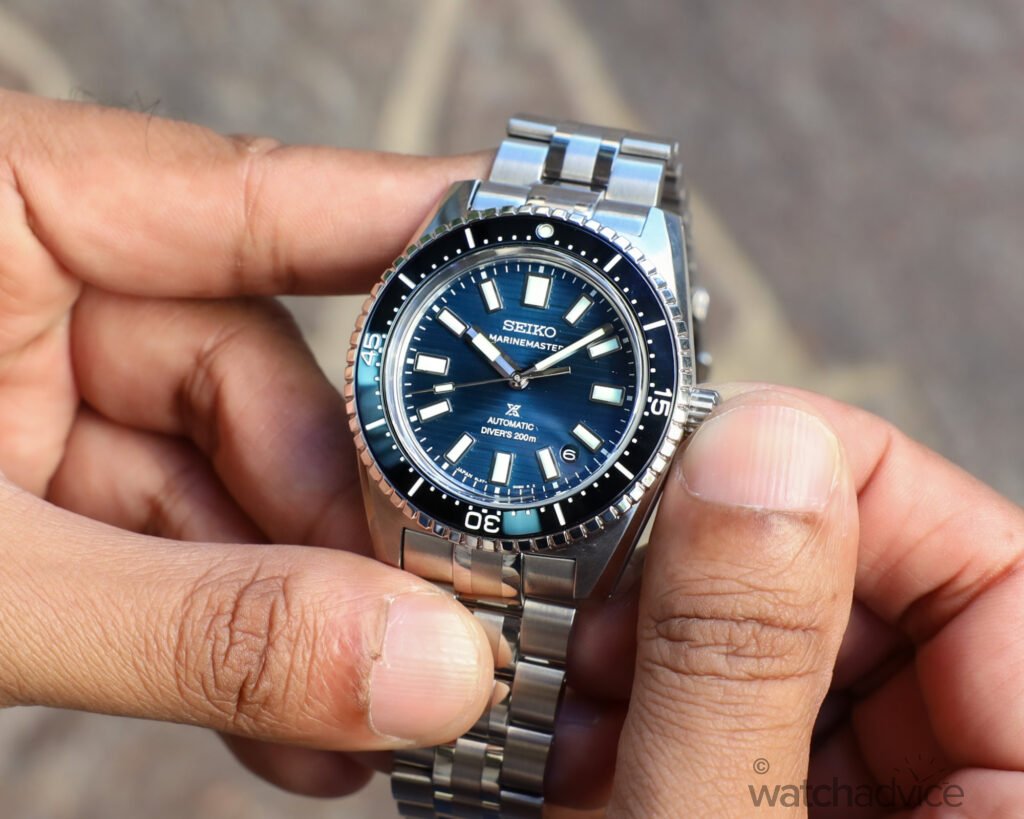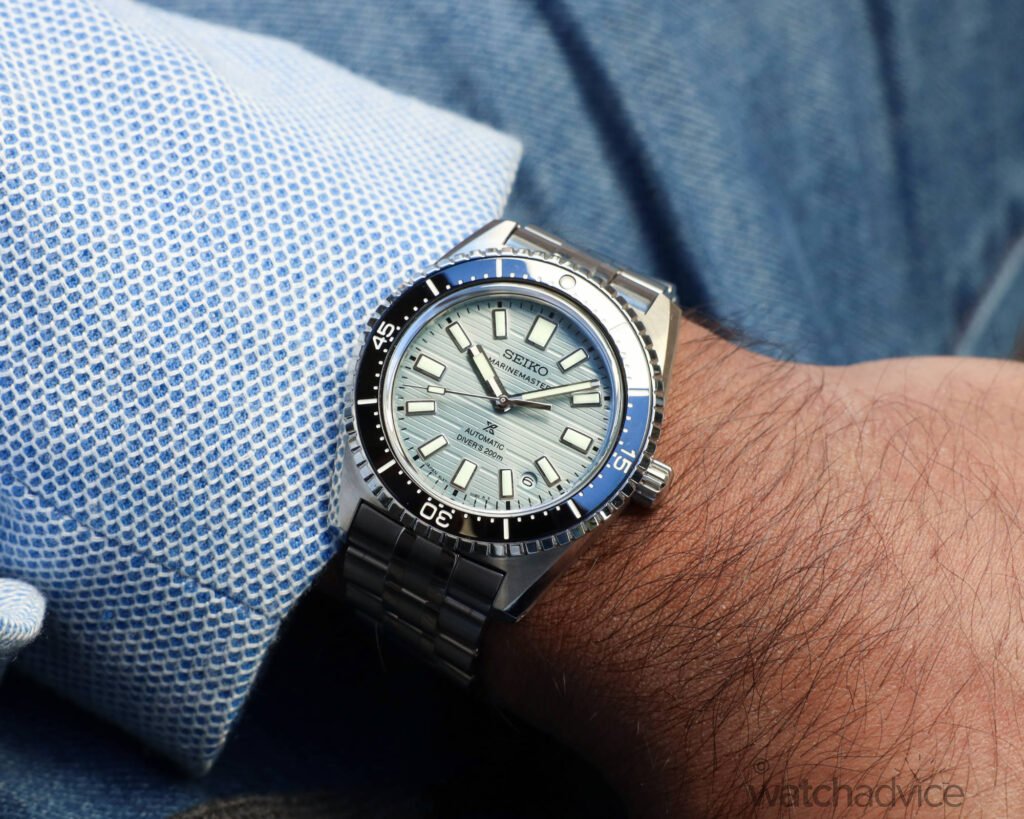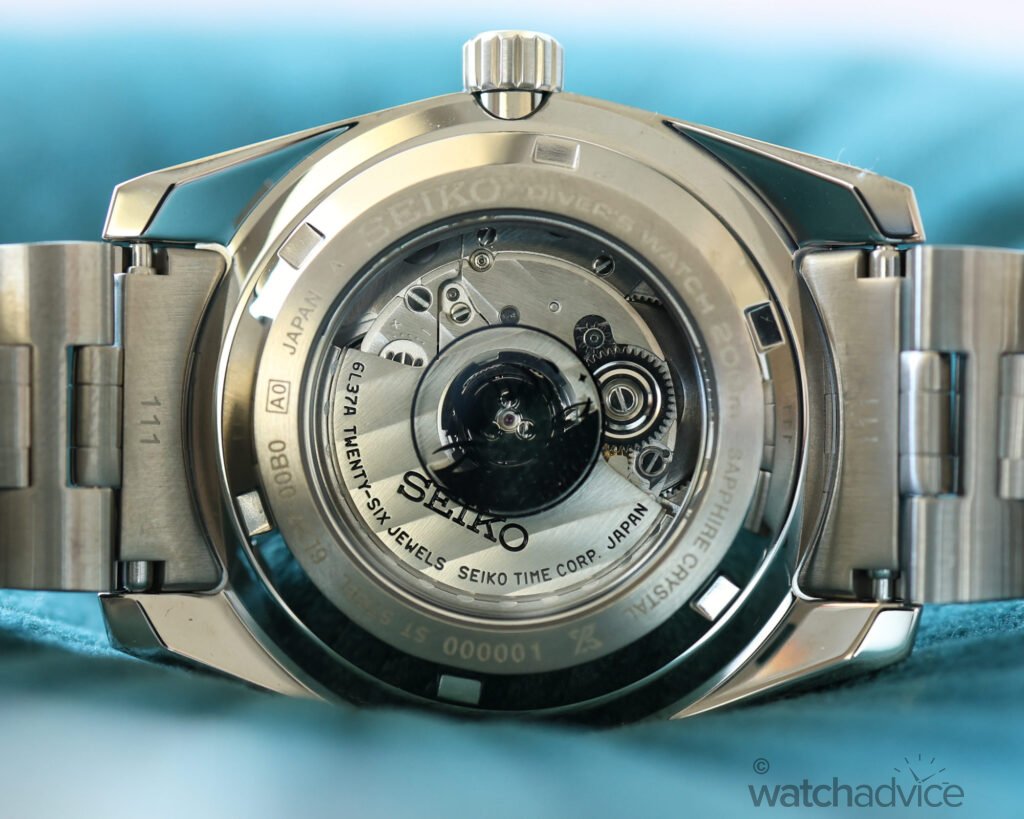In this latest hands-on review, we look at Seiko’s Prospex Marinmaster, a reinterpretation of the brand’s first-ever 1965 diver’s watch.
What We Love:
- The mix of brushed and polished surfaces on the case, bracelet and dial
- The dial pattern and colour are stunning in person.
- Open case back showing movement for the first time in a Seiko diver.
What We Don’t:
- The bracelet clasp design is not suited for high-end Seiko divers.
- Open case back could show more of the movement.
- The date window could have been placed better for a more balanced dial view.
Overall Rating: 8.6/10
- Value for Money: 8.5/10
- Wearability: 8.5/10
- Design: 9/10
- Build Quality: 8.5/10
Seiko first introduced a trio of Prospex Marinemaster models in late 2023. These timepieces merged two of the brand’s best heritage diver timepieces, the Marinemaster from 2000 and the classic first-ever Seiko divers watch, the 1965 62MAS. Combining two signature designs to make a brand new modern diver’s timepiece.
The 2023 Prospex Marinemaster models showcase Seiko’s renowned craftsmanship and dedication to creating excellent dive watches. The collection uses a rugged design along with beautiful dial aesthetics to make it known that it can be used as both a tool watch and a daily wearer. The Prospex Marinemaster also uses the iconic Seiko watch designs from the above-mentioned references.
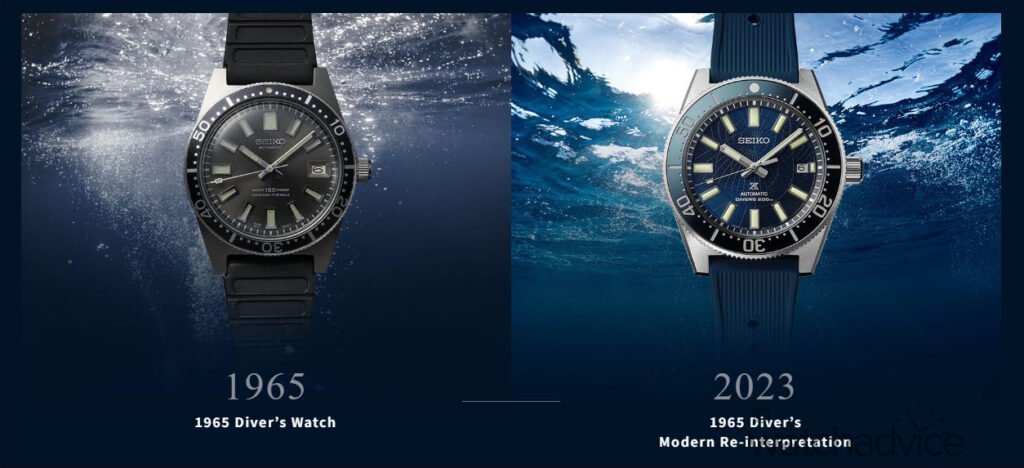
Seiko is well known for bringing classic timepieces back to life with their re-interpretations, with the brand already releasing modern versions of the Seiko Prospex 1965, Prospex 1968 and Prospex 1970. The original divers watch, the 1965 62MAS, has already been reimagined a few times, with the Save The Ocean Limited Edition model (click here to see the timepiece) being one of my favourites with its unique patterned dial that echoes a marine astrolabe. Last year, Seiko also did a faithful re-creation of the 1965 Diver, referencing the original’s aesthetic design in an accurate manner.
Related Reading – Seiko Launches Faithful Re-creation of Japan’s First Diver’s Timepiece.
Unlike the 62MAS, the Seiko Marinemaster is a more modern, diverse classic. The first automatic Seiko Marinemaster, the 300 SBDX001, was released in 2000 and sold exclusively for the Japanese market. This makes the Marinemaster 24 years old to date, and it still makes a great, affordable tool watch for divers.
One of the stand-out features of the Seiko Marinemaster is its monoblock case construction. The first Marinemaster was approximately 16mm thick, making it one thick piece. Measuring 44mm in diameter, it was also quite a large model, but in its defence, people were still opting to buy larger case watches back then, unlike modern times where smaller and slimmer models are the trend.
The Marinemaster also came with 300m of water depth resistance. Combine this with its bulky case; it was one solid timepiece. I personally prefer dive watches to be slightly bulkier, so that wrist presence is easily noticeable. In saying that, whether I would wear a 44mm x 16mm size piece is another question entirely.
I think this is where the Seiko Prospex Marinemaster models have done well. The brand has taken what works well from its reference timepieces (62MAS/Marinemaster) and developed a new model to suit modern design standards. When the three Prospex Marinemaster timepieces (Ref. SJE099, SJE101 and limited-edition SJE097) were released, they measured 39.5mm diameter x 12.3mm thickness and had a lug-to-lug distance of 47.2mm. The case size and thickness are almost perfect, especially for slim wrists like mine, while still being “bulky” enough for me to feel the watch’s presence.
This month, in July 2024, Seiko released two new variants of the Prospex Marinemaster. These two models come with a grey dial or a stunning deep blue dial. Both new models carry the same specs and dimensions as per the trio of Prospex Marinmaster timepieces released.
Out of these models that were released, we chose to review the cool ice blue “Clearwater” and the royal blue dials because, let’s face it, while the black and white dials are nice in their own regard, the blues dial brings the “wow” factor. All three dials were named and designed with different water conditions in mind, with the black dial being “Dark Water” and the white dial being “High Water”.
My first impression of the ice blue “Clearwater” dial Prospex Marinemaster was that I was immediately drawn to the dial and, more specifically, its pattern. While I will go into this more deeply later on, the horizontal stripes are a new addition to the Prospex diver’s timepieces, giving them a sporty look similar in design to the iconic Patek Philippe Nautilus.
Case Design
This timepiece takes inspiration from two icons of Seiko divers. I noticed that it heavily references the original 1965 62MAS. The case construction is more akin to the Marinemaster, as the 62MAS has a “flat” surface compared to the chamfered edges on the case of the new Prospex Marinemasters.
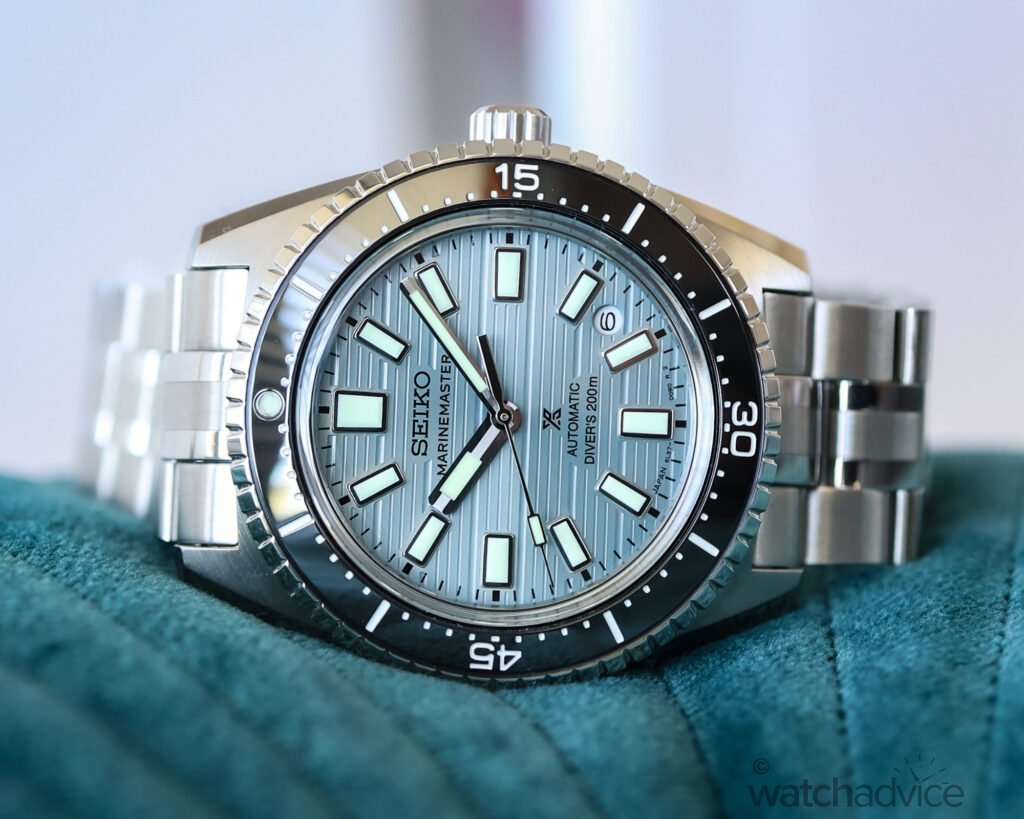
The 39.5mm profile of the case means that for my slim wrists, it is certainly not a large watch, and the fit feels just right. What also helps this cause is how the lugs taper slightly downwards, helping to achieve a better snug fit on the wrist. In addition to this, the bezel also features a tapered edge, which aesthetically looks great when matched with the lug’s taper. The bezel also has a knurling design that gives it the “rugged” aesthetic I mentioned at the start of the article. When you place this against the rest of the timepiece, which has a refined, sharp and more “luxurious” design, it gives the watch more character and emphasises the fact that this is indeed a tool watch.
The bezel insert is super crisp and legible, with a nice contrast between blue and white markings. Its operation is smooth, and you certainly notice the small movements between each “click.” What I also really like about the bezel is the insert’s mirror-like finish, which plays with light beautifully. Depending on the light angle, it can go from a dark navy blue to a light royal blue colour.
The bezel’s ability to play well with light is also showcased through the case and its different finishings. The majority of the case has a brushed finish, which you can clearly see on the lugs and case sides. However, where the case has chamfered edges, Seiko has given these sections a polished finish that gives a beautiful shine when rotating the watch under a light. Seiko states the reason for the polished finishing is that “The edges of the case and bezel are mirror-finished to prevent snagging and damage to the equipment used by divers, creating a brilliant appearance while improving functionality.” Aesthetic-wise, the fact that the polished finish is surrounded by the more “subtle” appearance of the brushed finish makes it stand out all the much more.
The biggest improvement in the case design is that it features an open case back, which is the first for a diver’s timepiece in Seiko’s history! The Marinemaster’s exhibition case back allows a view into the beautifully finished movement. Now, we aren’t talking Grand Seiko level of movement finishing, but just being able to see the movement is a major bonus here.
Dial Design:
The press photos for these two timepieces do not do the watch justice. They simply don’t pick up the minor details, which makes the dial more intricate and aesthetically pleasing. Of course, the right colour combination helps as well.
Seiko offers the Prospex Marinemaster in five colour variations. We get the initial three: the white dial with white bezel, the black dial with black bezel, and the ice blue dial with navy bezel. The latest two versions, released this month, come with a royal blue dial with a matching bezel or a grey dial with a black bezel. The five colour variations are all vastly different from each other, which is great as it offers the buyer a wide range to suit their personal taste.
If you like subtle appearance, the black, white, and grey dials are the go-to choice. I also feel the horizontal line pattern on the white dial is not as prominent compared to the other models, as it seems to blend in together from some distance. My personal preference is the ice blue and royal blue dials. These colours work well to accentuate the details of the dial while also contrasting against other elements, such as the hour indices and hands, to make them stand out as well.
When I first saw the horizontal line pattern on the dial, it immediately reminded me of wooden planks with horizontal grooves. I know this may not have been the intention, but as this is a diving timepiece, it makes me think of wooden sailing ships! The dial features large hour indices with quite a large amount of lume. The 3, 6, and 9-hour markers are also larger in size, while the 12 o’clock marker is twice the size of the standard hour marker, making these indices stand out even more. The hour and minute hands also have a generous amount of LumiBrite. Upon closer inspection of the dial, you’ll notice that the hands have a mixture of polished and brushed finishing, which makes them shine beautifully at different angles of light.
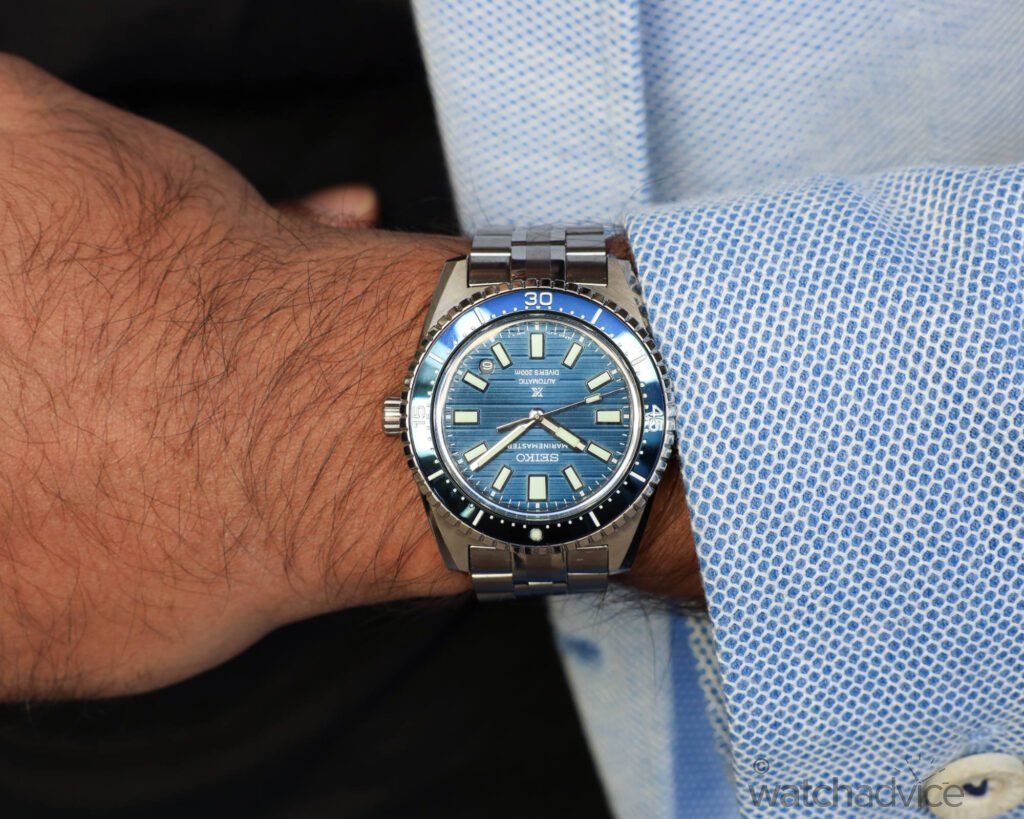
One downside of the ice blue dial compared to the royal blue and black dial is that it doesn’t contrast as well against the hour indices and hands. However, this becomes a non-issue in low-light conditions, for when the lume is activated, the watch lights up and becomes noticeable from some distance.
Another minor flaw I can see with the dial is the date window placement. Sitting between the 4 and 5 o’clock hour markers, for me, it offers an unbalanced look of the dial. Normally, I would love to see the date window replace either the 3 or 6 o’clock hour indices so it seems more of a seamless transition between the markers; however, depending on the size of the date window, that may also be an issue on this timepiece. With how large the hour indices are, having a small date window like it is now would make it seem just as out of place. I think Seiko knew of this issue, which is why they have tried to make the date window as subtle as it can be by making the window the smallest possible size and then matching the date wheel colour to the rest of the dial.
Calibre 6L37 Movement
The thin, high-performance 6L37 movement is the result of more than 100 years of heritage and technical transmission.
Seiko
The Seiko 6L37 movement was first introduced in July 2023 in the Prospex 1965 Diver’s Re-creation Limited Edition. It was the first movement from the Seiko slimline 6L family made exclusively for dive watches. The Calibre 6L37 is Seiko’s thinnest automatic movement ever, at just 3.69mm!

The 6L37 movement is used only for automatic 3-hander timepieces with the date complication. The base model for this movement was the trusted and robust Seiko 6L35 movement, which shares the same framework and architecture. While it’s unclear what the major differences are between the two movements, the brand states that the 6L37 was created specifically for diving timepieces, with an increase in shock resistance and durability in mind when creating the movement.
The Calibre 6L37 movement comes with two of Seiko’s original technologies. The first is the SPRON Seiko original alloy. SPRON is used for the mainspring and hairspring. It was developed specifically to be resistant to tear, corrosion, and wear. The use of this special alloy allows the movement to be more durable and long-lasting while maintaining precision and accuracy.
The second and most widely known Seiko technology is Diashock. The brand describes Diashock as “a structure developed to enhance the movement’s resistance to shocks. It is used as a bearing, such as for the balance wheel pivot, a section of the movement that is especially sensitive to shocks and jolts. With Diashock, the structure maintains high stability even when subjected to sudden shocks.”
Considering all of this, the Seiko Calibre 6L37 movement produces a decent power reserve of approximately 45 hours while operating at a high frequency of 28,800 VpH (4hz) (11 beats per second). As mentioned previously, the timepiece, comes with an open case back (a first for a diver!), which allows the wearer to have a view of the movement. Now, while much of the movement is covered with the winding rotor, we are treated to Geneva stripes finishing. I also feel that the brand could have done away with the Tsunami logo or at least made it as transparent as possible. As this is the first time one of Seiko’s divers is getting an open case back, it should have been important to show as much of the movement as possible.
How Does The Seiko Prospex Marinemaster Wear?
The Seiko Prospex Marinemaster wears well on the wrist. With a case diameter of 39.5mm and a lug-to-lug distance of 47.2mm, it sits on my very slim wrists quite nicely, contouring nicely to the edges of my wrist. With a height of only 12.3mm it hits a sweet spot of being a bit thick while not being too bulky. Which personally I really like. If you had the chance to read my review of the Tissot PRX (click here for review!) you’ll see that my transition to thin timepieces was quite a challenge at first, as I’ve been used to having weighty thick timepieces in my collection.
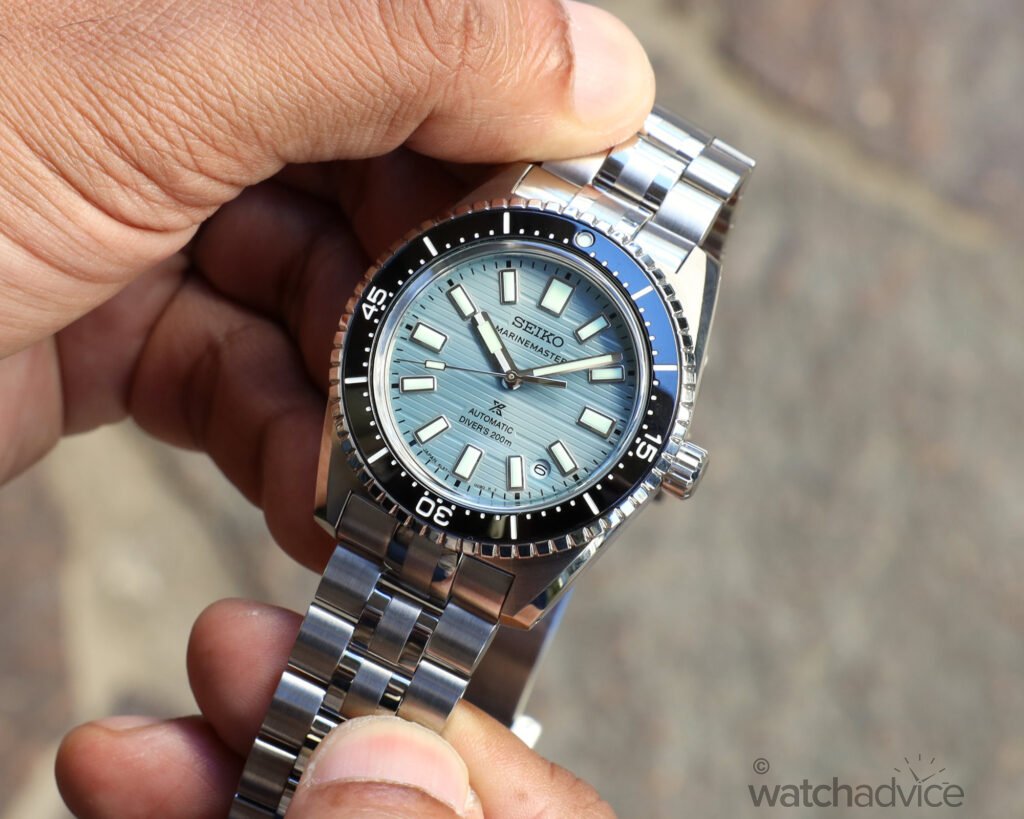
The bezel is quite easy to operate with its rectangular notches, and I can’t see it being an issue for a diver either, even with dive gloves on. The five-link bracelet comes with a mix of different finishes, which is reflective of the case. The two outer and central links have vertical brushed finishing, while the two middle links have mirror-like polished finishing. This translates to the bracelet being able to play with light beautifully and exude a nice shine.
The only downside to this bracelet is the clasp. For the price you are paying, I feel Seiko could’ve executed the clasp better. I bought a Seiko Sports 5 model quite a few years ago at a fraction of this timepiece’s price, and it features a similar clasp aesthetic design. The clasp, however, does come with a vertical brushed finish, which continues on from the bracelet. In the grand scheme of things, this isn’t a major issue, as the majority of the bracelet is still beautifully crafted for a great fit.
Final Thoughts
The Seiko Marinmaster is the end product of two iconic Seiko diver timepieces. Retaining the 1960s 62MAS and 2000s Marinemaster heritage, the brand has given this new diver a modern update with a new divers movement and new dial design.
However, the question lies in whether it’s justified to pay $4650 AUD retail. Without taking into account discounts, there is quite a bit of competition for this model at this price. It’s also important to note that, like most other luxury watchmakers, pricing for timepieces has risen significantly over the past few years. What justifies the price point for me is the fact that this is a diver’s watch with a 200m water rating, with a high level of finishing detail that you would find on timepieces with a more dressy or elegant luxury approach.
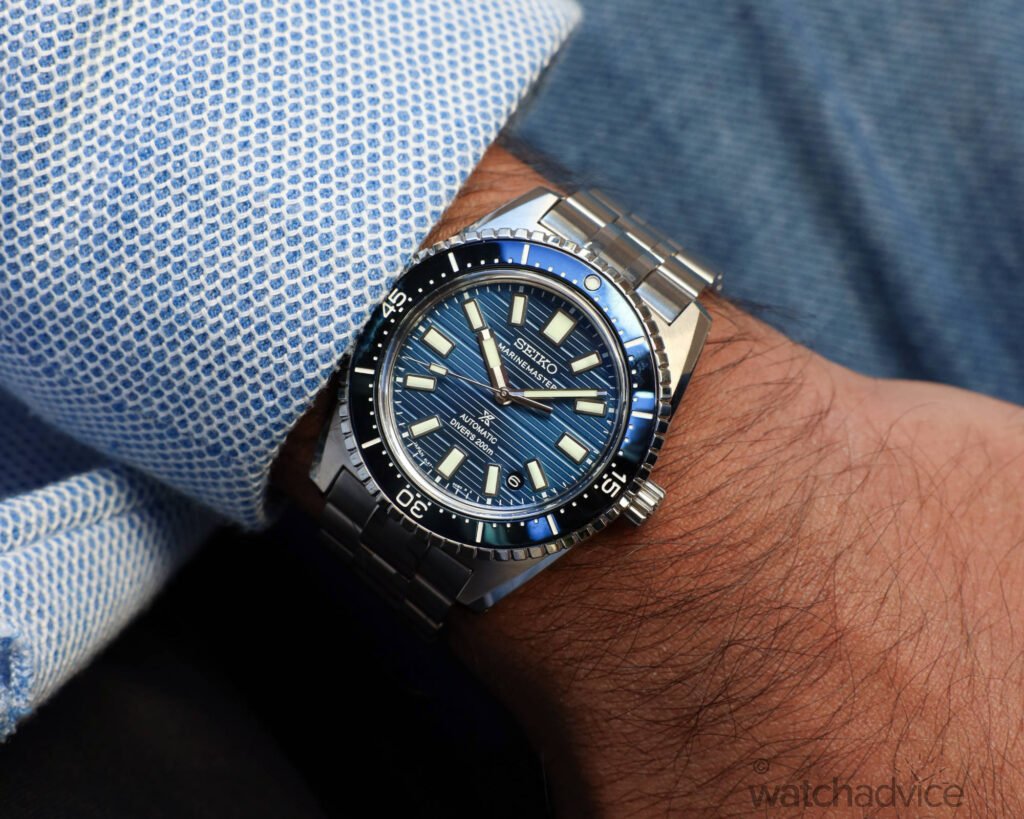
The watch plays with light beautifully; there’s no denying that. With a mix of brushed and polished surfaces on the case, bracelet, and even the hands on the dial, the timepiece exudes the luxury level of finishing that you would expect from timepieces in the price range and higher. The dials are also beautifully crafted, with the fine details being visible upon closer inspection. And as a divers watch, it doesn’t get any clearer in terms of lume and visibility than this Seiko Prospex Marinemaster. The large hour indices and hands work well to produce an excellent (and stunning) display of lume in low-light conditions. While the different dial colours will obviously impact the readability of the dial depending on the contrast, it’s not something that’s a deal break. In fact, my favourite model, the ice blue dial (Ref. SJE099), looks beautiful on the wrist while still being an easy-to-read dial.
The timepiece is not without its flaws, however. As mentioned earlier, Seiko could’ve done a better job on the bracelet clasp. I personally think they could’ve also done away with the tsunami logo or made it more transparent. The date window placement could’ve been better suited to either the 3 or 6 o’clock hour window with a larger window to balance the view of the hour markers as well. However, Seiko has tried to address these issues as best as it can while still offering the functionality, features and aesthetics of a luxury diver watch.
Reference: SJE099 (Ice Blue Dial), SJE119 (Royal Blue)
Specifications
- Case Size: 39.5mm
- Case Lug-to-Lug: 47.2mm
- Case Thickness: 12.3mm
- Case Material: Brushed and polished stainless steel
- Dial: Ice blue (SJE009) or royal blue (SJE119) dial with a horizontal line pattern.
- Movement: Automatic winding Calibre 6L37
- Power Reserve: Approx. 45 hours
- Water Resistance: 200m (20 bar)
- Crystal: Box-shaped sapphire crystal
- Strap/Bracelet: Five-link bracelet with brushed and polished finishing. Three-fold clasp with secure lock , push button release with extender.


